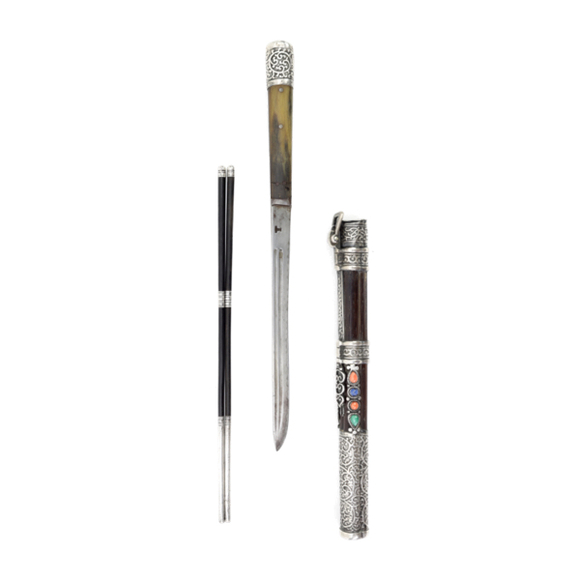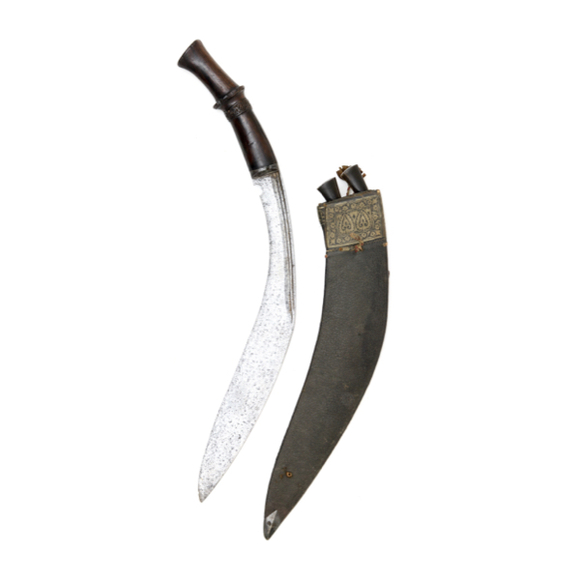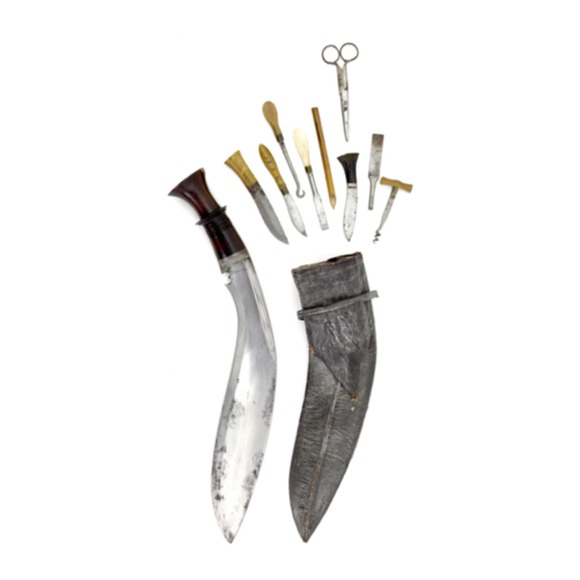Language: French / English speaking collector jargon
Source: In common use
Description
Trousse is originally a French word that means a case or kit. Among the English speaking arms collector's world, it is often used for a set containing a knife and other tools.
Many cultures produced their forms of trousse, including most European cultures but also the Ottomans, various Indian cultures, all the way to East Asia.

A German hunting trousse set by Jakob Watzky, circa 1650.
Metropolitan Museum accession number 68.141.247a–g.

A north Indian trousse katar.
Sold by Mandarin Mansion in 2020.
The Chinese trousse
One of the most common sets of trousse on today's market are those from China. They usually consist of a knife that fits into the same scabbard with a set of chopsticks. Sometimes other tools are also included like toothpicks, skewers, tweezers, etc. Elaborate sets in bigger cases can even contain cups, spoons, and other items.

A Chinese trousse set with silver chopsticks and white jade toggle.
Private collection.

Chinese trousse set with engraved brass mounts and bone chopsticks.
Mandarin Mansion inventory 2022.

Mongolian trousse set with flint striker.
Private collection.

Elaborate Manchu trousse set with archer's thumb ring and silver spoon.
Author's collection.
History of the Chinese trousse
A knife and chopsticks carried in a single sheath go back at least until the early 12th century. The first instance I am aware of is a painting in the Metropolitan Museum, attributed to Huang Zongdao who was active in the early 12th century.

Metropolitan Museum accession number 1982.3.1
Edward Elliott Family Collection, Purchase, The Dillon Fund Gift, 1982.

Close up of trousse in above image.
The knife handle and chopsticks can be clearly seen.
Historical anecdotes on Chinese trousse
"September 8. - We got up feeling pretty seedy and stiff, and were glad to start off and walk a few miles, as far as the top of the Adjod La. for the first time on the journey we had a Chinese soldier armed with sword and matchlock; usually the knife in their chopsticks case is their only weapon."
-William Woodville Rockhill, 1892
William Woodville Rockhill; Diary of a journey through Mongolia and Tibet in 1891 and 1892, Published by the Smithsonian Institution, City of Washington, 1894. Page: 330.
"September 17. - The Bat'angites are very much Chinesefied and have lost many of the pleasing traits I noticed in the Wilder tribes of the West. (...) The men do not usually carry the long sword common among Tibetans; most of them have only a Chinese knife and chopsticks, though a few carry a short dirk of Shigatsé make and of decidedly Indian pattern."
-William Woodville Rockhill, 1892
William Woodville Rockhill; Diary of a journey through Mongolia and Tibet in 1891 and 1892, Published by the Smithsonian Institution, City of Washington, 1894. Page: 346.
"The South Koko-nor Tibetans are on the whole jovial, and roars of laughter and merry song are not uncommon in their encampments. Musical instruments are, however, not found among them except the drum and cymbals. Their needs are few, and apparently they are contented, each having his one or two garments, a matchlock, sword, flint and steel, a wooden basin, knife and chopsticks (the latter less needful, the fingers serving)."
-Susie Carson Rijnhart, 1901
Susie Carson Rijnhart; With the Tibetans in Tent and Temple: Narrative of Four Years' Residence on the Tibetan Border, and of a Journey Into the Far Interior. F. H. Revell company, Chicago, New York. 1901. Page 178.






